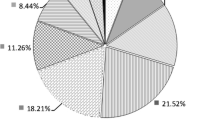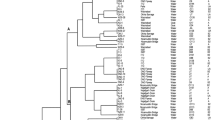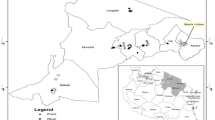Abstract
A total of 240 water-borne bacteria including 72 Escherichia coli, 83 Enterobacter, 30 Klebsiella, 36 Salmonella and 19 Shigella spp. isolates from drinking and recreational water sources were assessed for antibiotic resistance and genetic diversity. Escherichia coli (88.89 %) and species of Enterobacter (86.75 %), Klebsiella (83.33 %) and Salmonella (100 %) were resistant to cefadroxil, while >94 % Shigella spp. were resistant to cefaclor and cefuroxime. Ofloxacin was the most effective antibiotic against isolates of all the genera. Multiple antibiotic resistance index identified dug well, pond and piped water supplies as high risk sources of enteric pathogens. Random amplified polymorphic DNA analysis and restriction fragment length polymorphism of amplified 16S rRNA gene were studied for genetic relatedness of Enterobacteriaceae isolates. Primer P1254 identified 10, 16, 4, 4 and 1 distinct random amplified polymorphic DNA group(s) of E. coli, Enterobacter, Klebsiella, Salmonella and Shigella species, respectively. Unlike random amplified polymorphic DNA, restriction fragment length polymorphism using AluI and HaeIII could not segregate isolates in different genetic profiles. 16S rRNA gene of three Enterobacter spp. strains from different sources with similar restriction fragment length polymorphism but different random amplified polymorphic DNA patterns was sequenced, and identified as Enterobacter hormaechei strains skg0061, 0062 and 0063. The sequence information has been submitted to GenBank (HQ322393-95). Biochemically similar but genetically diverse Enterobacteriaceae members from drinking and recreational water sources exhibited varying antibiotic sensitivity. Contamination of water sources with such multiple antibiotic-resistant enteric pathogens poses threat to human health.



Similar content being viewed by others
References
Allen HK, Donato J, Wang HH, Cloud-Hansen KA, Davies J, Handelsman J (2010) Call of the wild: antibiotic resistance genes in natural environments. Nature Rev Microbiol 8:251–259
Amann R, Ludwig W, Schleifer KH (1994) Identification of uncultured bacteria: a challenging task for molecular taxonomists. ASM News 60:360–365
Bauer AW, Kirby WM, Sherris JC, Turck M (1966) Antibiotic susceptibility testing by a standardized single disk method. Am J Clin Pathol 45:493–496
Benson DA, Karsch-Mizrachi I, Lipman DJ, Ostell J, Wheeler DL (2007) GenBank. Nucleic Acids Res 35(Database issue):21–25
Betancor L, Schelotto F, Martinez A, Pereira M, Algorta G, Rodríguez MA, Vignoli R, Chabalgoity JA (2004) Random amplified polymorphic DNA and phenotyping analysis of Salmonella enterica serovar enteritidis isolates collected from humans and poultry in Uruguay from 1995 to 2002. J Clin Microbiol 42:1155–1162
Bhagat S (2011) Faecal bacteria found in drinking water samples. Times of India, 26 Feb 2011. http://timesofindia.indiatimes.com/city/mumbai/Faecal-bacteria-found-in-drinking-water-samples/articleshow/7578211.cms??prtpage=1. Viewed 8 April 2011
Blumberg HM, Kiehlbauch JA, Wachsmuth IK (1991) Molecular epidemiology of Yersinia enterocolitica O:3 infections: use of chromosomal DNA restriction fragment length polymorphisms of rRNA genes. J Clin Microbiol 29:2368–2374
Broda DM, Musgrave DR, Bell RG (2000) Use of restriction fragment length polymorphism analysis to differentiate strains of psychrophilic and psychrotrophic clostridia associated with ‘blown pack’ spoilage of vacuum packed meats. J Appl Microbiol 88:107–116
Brunel B, Givaudan A, Lanois A, Akhurst RJ, Boemare N (1997) Fast and accurate identification of Xenorhabdus and Photorhabdus species by restriction analysis of PCR-amplified 16S rRNA genes. Appl Environ Microbiol 63:574–580
Chun J, Lee JH, Jung Y, Kim M, Kim S, Kim BK, Lim YW (2007) EzTaxon: a web-based tool for the identification of prokaryotes based on 16S ribosomal RNA gene sequences. Int J Syst Evol Microbiol 57:2259–2261
Diwan V, Tamhankar AJ, Khandal RK, Sen S, Aggarwal M, Marothi Y, Iyer RV, Sundblad-Tonderski K, Stålsby-Lundborg C (2010) Antibiotics and antibiotic-resistant bacteria in waters associated with a hospital in Ujjain, India. BMC Public Health 10:414
Drlica K, Zhao X (1997) DNA gyrase, topoisomerase IV, and the 4-quinolones. Microbiol Mol Biol Rev 61:377–392
Felsenstein J (1985) Confidence limits on phylogenies: an approach using the bootstrap. Evolution 39:783–791
Girão DM, Bando SY, Girão VBC, Moreira-Filho CA, Fracalanzz SEL, Trabulsi LR, Monteiro-Neto V (1999) Characterization of typical and atypical enteropathogenic Escherichia coli (EPEC) strains of the classical O55 serogroup by RAPD analysis. Revista de Microbiologia 30:365–368
Gray JT, WaKabongo M, Campos FE, Diallo AA, Tyndal C, Tucker CA (2001) Development recognition of Yersinia enterocolitica multiple strain infection in twin infants using PCR-based DNA fingerprinting. J Appl Microbiol 90:358–364
Hinton M, Rixson PD, Allen V, Linton AH (1984) The persistence of drug resistant Escherichia coli strains in the majority faecal flora of calves. J. Hygiene Lond 93:547–557
Holt JG, Krieg NR, Sneath PHA, Staley JT, Williams ST (1993) Bergey’s manual of determinative bacteriology, 9th edn. Williams and Wilkins, Baltimore
Iriarte P, Owen RJ (1996) PCR-RFLP analysis of the large subunit (23S) ribosomal RNA genes of Campylobacter jejuni. Lett Appl Microbiol 23:163–166
Janda JM, Abbott SL (2007) 16S rRNA gene sequencing for bacterial identification in the diagnostic laboratory: pluses, perils, and pitfalls. J Clin Microbiol 45:2761–2764
Jiang ZD, Lowe B, Verenkar MP, Ashley D, Steffen R, Tornieporth N (2002) Prevalence of enteric pathogens among international travellers with diarrhea acquired in Kenya (Mombasa), India (Goa), or Jamaica (Montego Bay). J Infect Dis 185:497–502
Kilic A, Muz A, Ertas HB, Özbey G (2009) Random amplified polymorphic DNA (RAPD) analysis of Escherichia coli isolated from chickens. F Ü Sağ Bil Vet Derg 23:1–4
Kim JY, Kim SH, Kwon NH, Bae WK, Lim JY, Koo HC, Kim JM, Noh KM, Jung WK, Park KT, Park YH (2005) Isolation and identification of Escherichia coli O157:H7 using different detection methods and molecular determination by multiplex PCR and RAPD. J Vet Sci 6:7–19
Kirschner P, Springer B, Vogel U, Meier A, Wrede A, Kiekenbeck M, Bange FC, Bottger EC (1993) Genotypic identification of mycobacteria by nucleic acid sequence determination: report of a 2-year experience in a clinical laboratory. J Clin Microbiol 31:2882–2889
Krumperman PH (1983) Multiple antibiotic resistance indexing of Escherichia coli to identify high-risk sources of fecal contamination of foods. Appl Environ Microbiol 46(1):165–170
Kullen MJ, Amann MM, O’Shaughnessy MJ, O’Sullivan DJ, Busta FF, Brady LJ (1997) Differentiation of ingested and endogenous bifidobacteria by DNA fingerprinting demonstrates the survival of an unmodified strain in the gastrointestinal tract of humans. J Nutr 127:89–94
Kumar S, Tripathi VR, Garg SK (2012) Physicochemical and microbiological assessment of recreational and drinking waters. Environ Monit Assess 184:2691–2698. doi:10.1007/s10661-011-2144-1
Lane DJ, Pace B, Olsen GJ, Stahl DA, Sogin ML, Pace NR (1985) Rapid determination of 16S ribosomal RNA sequences for phylogenetic analyses. Proc Natl Acad Sci USA 82:6955–6959
Li JW, Shi XQ, Chao FH, Wang XW, Zheng JL, Song N (2004) A study on detecting and identifying enteric pathogens with PCR. Biomed Environ Sci 17:109–120
Ludwig W, Schleifer KH (1994) Bacterial phylogeny based on 16S and 23S rRNA sequence analysis. FEMS Microbiol Rev 15:155–173
Miteva V, Boudakov I, Stoyancheva GI, Marinova B, Mitev V, Mengaud J (2001) Differentiation of Lactobacillus delbrueckii subspecies by ribotyping and amplified ribosomal DNA restriction analysis (ARDRA). J Appl Microbiol 90:909–918
Müller J, Friedl T, Hepperle D, Lorenz M, Day JG (2005) Distinction between multiple isolates of Chlorella vulgaris (Chlorophyta, Trebouxiophyceae) and testing for conspecificity using amplified fragment length polymorphism and ITS rDNA sequences. J Phycol 41:1236–1247
Neilan BA (1995) Identification and phylogenetic analysis of toxigenic cyanobacteria by multiplex randomly amplified polymorphic DNA PCR. Appl Environ Microbiol 61:2286–2291
O’Hara CM, Steigerwalt AG, Hill BC, Farmer III JJ, Fanning GR, Brenner Don J (1989) Enterobacter hormaechei, a new species of the family Enterobacteriaceae formerly known as enteric group 75. J Clin Microbiol 27:2046–2049
PulseNetUSA (2004) One day (24–28 h) standardized laboratory protocol for molecular subtyping of Escherichia coli O157:H7, non-typhoidal Salmonella serotypes, and Shigella sonnei by pulsed-field gel electrophoresis (PFGE). CDC, National Center for Infectious Diseases, Atlanta
Sayah RS, Kaneene JB, Johnson Y, Miller RA (2005) Patterns of antimicrobial resistance observed in Escherichia coli isolates obtained from domestic- and wild-animal fecal samples, human septage, and surface water. Appl Environ Microbiol 71:1394–1404
Shangkuan YH, Yang JF, Lin HC, Shaio MF (2000) Comparison of PCR-RFLP, ribotyping and ERIC-PCR for typing Bacillus anthracis and Bacillus cereus strains. J Appl Microbiol 89:452–462
Tamura K, Dudley J, Nei M, Kumar S (2007) MEGA4: molecular evolutionary genetics analysis (MEGA) software version 4.0. Mol Biol Evol 24:1596–1599
Tewari S, Ramteke PW, Garg SK (2003) Evaluation of simple microbial tests for detection of fecal coliforms directly at 44.5 degrees C. Environ Monit Assess 85:191–198
Thompson JD, Higgins DG, Gibson TJ (1994) CLUSTAL W: improving the sensitivity of progressive multiple sequence alignment through sequence weighting, position-specific gap penalties and weight matrix choice. Nucleic Acids Res 22:4673–4680
Troy MS, Rose JB, Jenkins TM, Farrah SR, Lukasik J (2002) Microbial source tracking: current methodology and future directions. Appl Environ Microbiol 68:5796–5803
Walsh TR, Weeks J, Livermore DM, Toleman MA (2011) Dissemination of NDM-1 positive bacteria in the New Delhi environment and its implications for human health: an environmental point prevalence study. Lancet Infect Dis 11:355–362
WHO (World Health Organization) (2008) Guidelines for drinking-water quality, incorporating 1st and 2nd addenda, vol 1, Recommendations, 3rd edn. WHO, Geneva
Wilson K (1997) Preparation of genomic DNA from bacteria. In: Ausubel FM, Brent R, Kingston RE, Moore DD, Seidham JG, Smith JA, Struhl K (eds) Current protocols in molecular biology. Wiley, New York, pp 2.4.1–2.4.5
Woese CR, Fox GE (1977) Phylogenetic structure of the prokaryotic domain: the primary kingdoms. Proc Natl Acad Sci USA 74:5088–5090
Acknowledgments
The authors are highly thankful to the University Grants Commission, New Delhi, India for financial support under minor research project [No. 33-465/2007(SR)]. The assistance by the Department of Science and Technology, Government of India under FIST programme and Government of Uttar Pradesh under Centre of Excellence scheme to our department is duly acknowledged. We are extremely thankful to Late Dr. Rakesh K. Jain and Mr. Surendra Vikram, Institute of Microbial Technology, Chandigarh, India for support, constant encouragement and facility for gene sequencing related works.
Conflict to interest
The authors declare that they have no conflict to interest.
Author information
Authors and Affiliations
Corresponding author
Rights and permissions
About this article
Cite this article
Kumar, S., Tripathi, V.R. & Garg, S.K. Antibiotic resistance and genetic diversity in water-borne Enterobacteriaceae isolates from recreational and drinking water sources. Int. J. Environ. Sci. Technol. 10, 789–798 (2013). https://doi.org/10.1007/s13762-012-0126-7
Received:
Revised:
Accepted:
Published:
Issue Date:
DOI: https://doi.org/10.1007/s13762-012-0126-7




